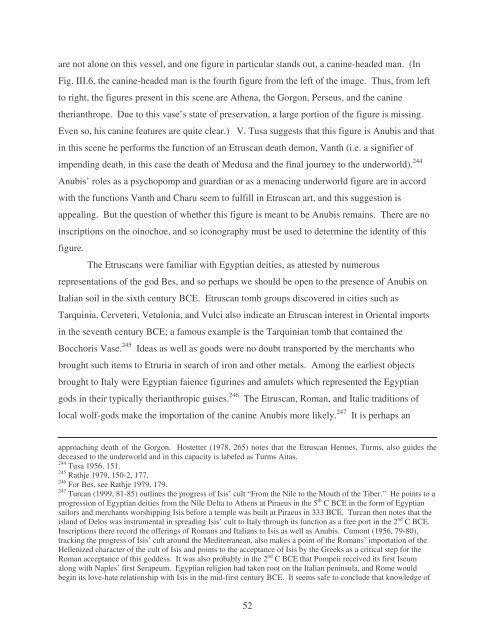Final Draft - Preview Matter - Florida State University
Final Draft - Preview Matter - Florida State University
Final Draft - Preview Matter - Florida State University
You also want an ePaper? Increase the reach of your titles
YUMPU automatically turns print PDFs into web optimized ePapers that Google loves.
are not alone on this vessel, and one figure in particular stands out, a canine-headed man. (In<br />
Fig. III.6, the canine-headed man is the fourth figure from the left of the image. Thus, from left<br />
to right, the figures present in this scene are Athena, the Gorgon, Perseus, and the canine<br />
therianthrope. Due to this vase’s state of preservation, a large portion of the figure is missing.<br />
Even so, his canine features are quite clear.) V. Tusa suggests that this figure is Anubis and that<br />
in this scene he performs the function of an Etruscan death demon, Vanth (i.e. a signifier of<br />
impending death, in this case the death of Medusa and the final journey to the underworld). 244<br />
Anubis’ roles as a psychopomp and guardian or as a menacing underworld figure are in accord<br />
with the functions Vanth and Charu seem to fulfill in Etruscan art, and this suggestion is<br />
appealing. But the question of whether this figure is meant to be Anubis remains. There are no<br />
inscriptions on the oinochoe, and so iconography must be used to determine the identity of this<br />
figure.<br />
The Etruscans were familiar with Egyptian deities, as attested by numerous<br />
representations of the god Bes, and so perhaps we should be open to the presence of Anubis on<br />
Italian soil in the sixth century BCE. Etruscan tomb groups discovered in cities such as<br />
Tarquinia, Cerveteri, Vetulonia, and Vulci also indicate an Etruscan interest in Oriental imports<br />
in the seventh century BCE; a famous example is the Tarquinian tomb that contained the<br />
Bocchoris Vase. 245 Ideas as well as goods were no doubt transported by the merchants who<br />
brought such items to Etruria in search of iron and other metals. Among the earliest objects<br />
brought to Italy were Egyptian faience figurines and amulets which represented the Egyptian<br />
gods in their typically therianthropic guises. 246 The Etruscan, Roman, and Italic traditions of<br />
local wolf-gods make the importation of the canine Anubis more likely. 247 It is perhaps an<br />
approaching death of the Gorgon. Hostetter (1978, 265) notes that the Etruscan Hermes, Turms, also guides the<br />
deceased to the underworld and in this capacity is labeled as Turms Aitas.<br />
244<br />
Tusa 1956, 151.<br />
245<br />
Rathje 1979, 150-2, 177.<br />
246<br />
For Bes, see Rathje 1979, 179.<br />
247<br />
Turcan (1999, 81-85) outlines the progress of Isis’ cult “From the Nile to the Mouth of the Tiber.” He points to a<br />
progression of Egyptian deities from the Nile Delta to Athens at Piraeus in the 5 th C BCE in the form of Egyptian<br />
sailors and merchants worshipping Isis before a temple was built at Piraeus in 333 BCE. Turcan then notes that the<br />
island of Delos was instrumental in spreading Isis’ cult to Italy through its function as a free port in the 2 nd C BCE.<br />
Inscriptions there record the offerings of Romans and Italians to Isis as well as Anubis. Cumont (1956, 79-80),<br />
tracking the progress of Isis’ cult around the Mediterranean, also makes a point of the Romans’ importation of the<br />
Hellenized character of the cult of Isis and points to the acceptance of Isis by the Greeks as a critical step for the<br />
Roman acceptance of this goddess. It was also probably in the 2 nd C BCE that Pompeii received its first Iseum<br />
along with Naples’ first Serapeum. Egyptian religion had taken root on the Italian peninsula, and Rome would<br />
begin its love-hate relationship with Isis in the mid-first century BCE. It seems safe to conclude that knowledge of<br />
52

















